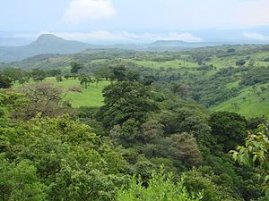Costa Rica Environmental Issues
"The problem of pollution is very serious, but it is not irreversible, " said water and sewer official Eduardo Lezama, who pointed to the lack of waste-water treatment and adequate trash-disposal facilities in the metropolitan area of San Josß as the chief culprit in the degradation of the river.
However, pressure to despoil one of the world's biodiversity treasure chests continues at the same time that government officials try to find ways of thwarting it. As Costa Rica's natural beauty and laid-back lifestyle increasingly makes it a mecca for well-heeled travelers and expatriates, environmentalists fear that a well-intended but cash-strapped government eventually will cave in to tempting offers from developers who, they say, would scar the country with discos, concrete beachfront houses and high-rise condominiums.
A TEEMING LAND
Covering only 19, 560 square miles (50, 900 square kilometers), an area about the size of West Virginia, Costa Rica contains an astonishing quantity of plant and animal life - about five percent of all known species on Earth. Its resident plants include more than 800 ferns, 1, 000 orchids and 2, 000 kinds of trees. Among its 200 animal species are jaguars, sloths, scarlet macaws, toucans, giant blue morpho butterflies, and the extravagantly plumed quetzal bird.
An hour's journey from the capital of San José would take a traveler through a dizzying array of ecosystems: dense rainforest, rare tropical dry forests, montane cloud forest cloaking the slopes of volcanoes, dry savanna, and soft white beaches. Just beyond the breakers lie jeweled strands of coral reefs.
One side of the country is lapped by the usually gentle waves of the Caribbean and is lined with five species of mangroves, along with swamps and sandy beaches. On the other side is the wild Pacific Ocean with its rugged gulfs and headlands.
Costa Rican rainforests have been compared to vaulted cathedrals, magisterial in their proportions. One writer declared that "a fourteenth-century stonemason would have felt at home with [the Costa Rican rainforest's] buttressed, moss-columned, towering trees and dark recesses."
SAVING THE WILD
Like other Central and South American countries, Costa Rica has been heavily deforested. However, most agree that Costa Ricans have responded the most vigorously of any other people in the world to threats to their natural patrimony.
Pressure to clear away the country's forests come from loggers, ranchers, and large-scale commercial agricultural ventures. The highlands, favored for production of coffee and tea, and the Pacific lowlands, with their beef and cotton industries, are especially threatened. During the 1960s large tracts of virgin forests were cleared to make way for cattle.
During the 1970s, the government responded by clamping down on the export of more than 60 species of trees, and began requiring permits for timbering. In 1993 it established a commission to thoroughly study and prescribe remedies for the country's growing environmental problems.
Today about 27 percent of the country is under some form of protection - the most of any country in the world - including almost 12 percent of the land designated as national parks. Other areas are set aside as forest and Indian reserves, wildlife refuges, and buffer zones.
Costa Rica has won numerous international awards for its ambitious conservation efforts. Nevertheless, deforestation - legal and otherwise continues to plague the country, especially in non-protected areas. While praising good intentions, environmentalists fault the government for spotty management and enforcement of regulations. And they warn of further degradation from development related to the country's booming tourist industry.
Eye in the Sky is a weekly series that brings you the story behind the headlines using satellite imagery, remote sensing, aerial photography, and maps. This feature is developed by National Geographic News with the sponsorship of the National Imagery and Mapping Agency (NIMA) and Earth-Info. Check out maps and imagery at .










